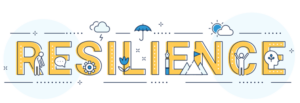Employees who feel safe and are mentally well also perform better on the job and are less likely to get physically injured.
Grief. Disappointment. Exhaustion. These are just a few of the things employees may be feeling as the pandemic drags on, as more climate issues arise, as “normalcy” feels further away.
Employers have an opportunity to support employees as they cope and build resilience.
“Many of us are tired, feel depleted, and are concerned about the future. It’s important to realize that being resilient doesn’t mean we don’t ever feel overwhelmed or experience struggle. It simply means we have the internal resources and abilities to adapt to stress and adversity,” says Liz Hill, Total Worker Health adviser at SAIF.
Why is it important to have resilient employees? While the pandemic, looming natural disasters, and the economy are today’s issues, there will always be hardship. Resilient employees will be able to adjust and cope with whatever hardship they encounter.
Employees who feel safe and are mentally well also perform better on the job and are less likely to get physically injured. See SAIF’s stress and mental well-being in the workplace page for more information.
Psychological safety
Building employee resilience starts with a psychologically safe workplace. To gauge whether your workplace promotes psychological safety, ask yourself these questions:
- Do employees feel they belong?
- Are employees able to learn?
- Are employees encouraged to share ideas?
- Are employees encouraged to question the way things are done?
“Workers who feel supported and psychologically safe are more productive and have lower risk of developing health issues, whether that be physical, emotional, or mental,” Hill says.
How to help employees cope
As an employer, you can make a difference in helping employees build resilience. Here are some tips:
- Talk about it. Help erase the stigma around mental health by bringing it up in the workplace.
- Foster a culture of wellbeing. Ideas for building this type of culture could be more flexible scheduling options, open communication between the worker and their supervisor to cultivate trust and honesty, and setting clear expectations.
- Develop your employee assistance program. Does your health plan and employee assistance program have accessible and affordable options for employees?
- Encourage employees to build their own resilience. According to the Bounce Back Project, there are five pillars of resilience: self-awareness, mindfulness, relationships, and self-care. How can you encourage employees to take advantage of these areas?
“Multiple surveys during the past 16 months have shown the impact of the pandemic and other world events on people’s mental health. People are more stressed, anxious, and have higher rates of depression than before the pandemic,” Hill says. “Workplaces can have a powerful protective effect by implementing policies and practices that help build resilience by providing safe environments both physically and psychologically.”
For more information on helping employees cope and build resilience, check out SAIF’s new resource on employee resilience, or visit their mental well-being resources on saif.com.
Information posted on the SAIF website on September 7, 2021.
